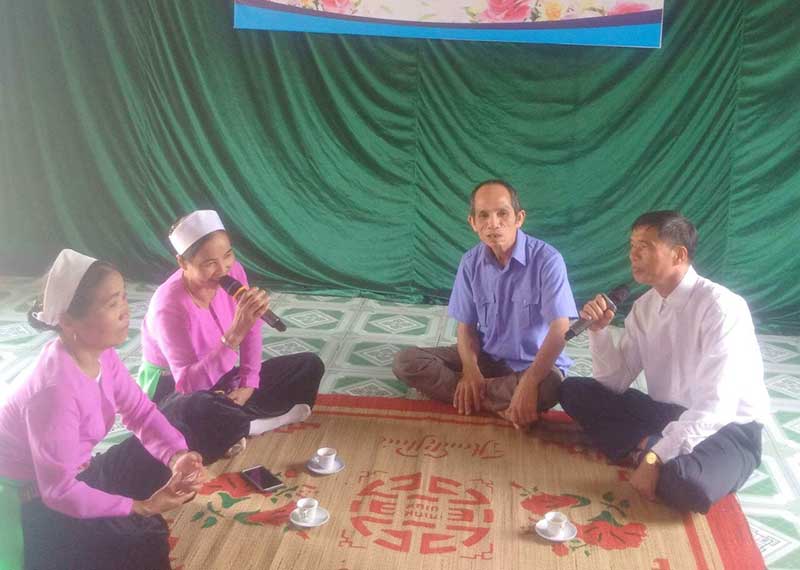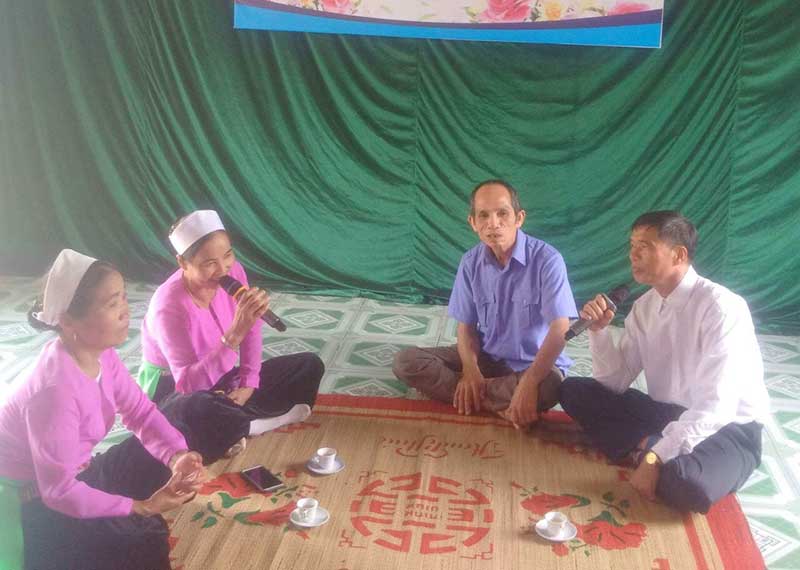
(HBO) - Mrs. Bui Minh Hong, Head of the Department of Culture and Information of Tan Lac district said: In order to preserve ethnic cultural character, communes and towns mobilized Muong women, youth and enthusiasts of Muong culture to establish teams of letters and arts performance for communities and hamlets. Everyone contributes funds to practice and develop local cultural and artistic movements.
 A Hat Doi (challenge-and-response)
singing act of members of cultural character preservation club of Hamlet Dinh
II, Man Duc Commune, Tan Lac district.
A Hat Doi (challenge-and-response)
singing act of members of cultural character preservation club of Hamlet Dinh
II, Man Duc Commune, Tan Lac district.
The district
Department of Culture and Information issued regulations to coordinate with the
district Women's Union to propagate and
mobilize members to establish a club to preserve Muong cultural character.
Every year, the district Department of Culture and Information organizes
training courses on skills of beating gongs and teaching folk songs for members
of letters and arts of communes, on that basis, encourages all communes to
establish cultural character preservation clubs.
Currently, Tan Lac
district established 02 cultural character preservation clubs, including: Ngoi
hamlet club (Ngoi Hoa commune) established in March 2017 and Dinh II hamlet
club (Man Duc commune) established in March 2019. The two clubs regularly
organize exchanges of culture and letters & arts; teach members and young
generations how to sing folk songs, folk dance, Hat Doi (challenge and
response) singing, beat gongs. Women maintain wearing ethnic costumes. The
special performances of Ngoi hamlet club have contributed to promoting the
culture and beauty of Muong Bi people to tourists.
The two clubs that
preserve ethnic cultural character in Ngoi Hoa and Man Duc Communes play an
important role in preserving and promoting Muong Bi's cultural values. In the
coming time, the district Culture and Information Department continues to
encourage communes and towns to establish clubs. Encouraging and creating
conditions for organizations and individuals to study, teach and introduce
Muong Bi customs, practices and culture.
With an increasingly vibrant and widespread emulation movement aimed at building cultured residential areas and cultured families, Yen Thuy District has been making steady progress toward improving both the material and spiritual well-being of its people, while fostering a civilized, prosperous, beautiful, and progressive community.
Once lacking recreational spaces and community facilities, Residential Group 2 in Quynh Lam Ward (Hoa Binh City) has recently received attention for the construction of a new, spacious, and fully equipped cultural house. The project followed the model of state support combined with public contributions in both labor and funding.
The "All people unite to build cultural life" movement, which has been effectively integrated with Kim Boi district’s socio-economic development goals, is fostering a lively spirit of emulation across local residential areas, hamlets, villages, public agencies, and enterprises. In addition, through the initiative, traditional cultural values are being preserved and promoted, while community solidarity and mutual support in poverty reduction and economic development are being strengthened.
A working delegation of the Hoa Binh provincial People’s Committee led by its Permanent Vice Chairman Nguyen Van Toan on June 11 inspected the progress of a project to build the Mo Muong Cultural Heritage Conservation Space linked to tourism services in Hop Phong commune, Cao Phong district.
Born and growing in the heroic land of Muong Dong, Dinh Thi Kieu Dung, a resident in Bo town of Kim Boi district, in her childhood was nurtured by the sweet lullabies of her grandmother and mother. These melodies deeply imprinted on her soul, becoming an inseparable part of her love for her ethnic group's culture. For over 20 years, this love for her hometown has driven Dung to research, collect, and pass down the cultural values of the Muong people to future generations.
In the final days of May, the Ethnic Art Troupe of Hoa Binh Province organized performances to serve the people in remote, mountainous, and particularly disadvantaged areas within the province. These were not just ordinary artistic shows, but they were the meaningful journeys aimed at spreading cultural values, enhancing the spiritual life of the people and contributing to the preservation of ethnic minority cultural identities.



 A Hat Doi (challenge-and-response)
singing act of members of cultural character preservation club of Hamlet Dinh
II, Man Duc Commune, Tan Lac district.
A Hat Doi (challenge-and-response)
singing act of members of cultural character preservation club of Hamlet Dinh
II, Man Duc Commune, Tan Lac district.